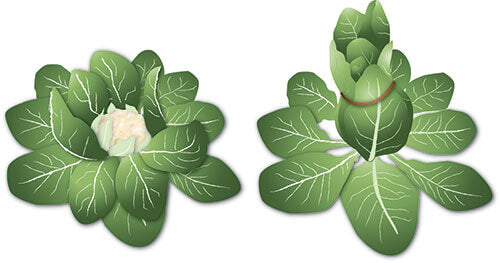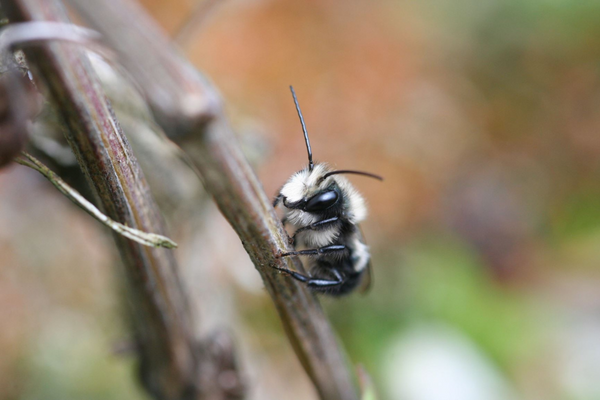About Cauliflower (Brassica oleracea Botrytis group)
Modern cauliflower has been grown since the 15th century, and it was grown almost exclusively in Italy until the 16th century when it gradually migrated to France and then to American gardens 100 years later. The Italians grew a variety of different kinds, including the traditional white and Romanesco, and various colours including purple, yellow, and green. In the 18th century German growers developed the annual cultivar which grows so well for summer and fall harvests. French gardeners perfected the biennial cultivar for winter and spring harvest in the 1800s, about the same time as an Asian variety was developed for tropical growing, as cauliflower became extremely popular in northern India and across China.

The English derivation of the word ‘cauliflower’ is from the Latin caulis, meaning ‘cabbage’ and ‘flower’.
In 1970, a Canadian farmer discovered a naturally mutated orange cauliflower that became big news for plant breeders. After 8 years of cross breeding, researchers at Cornell University and UBC managed to develop a consistently orange strain that contains 25 times the amount of vitamin A as conventional white types. Purple cauliflower contains the pigment anthocyanin, which also colours red wine and some cabbages. Anthocyanin is a powerful antioxidant. Green cauliflower is also available in two forms—with regular heads and as so-called Romanesco broccoli, which is actually a cauliflower. Romanesco has appealing, spiky, fractal-like heads.

Cauliflower is a very healthy thing to eat. High in dietary fibre and folate, and with no fat, a 100g serving also contains 77% of the recommended daily intake of vitamin C. Cauliflower is also packed with the B vitamins, several minerals, and a host of chemical compounds thought to strengthen the liver and detoxify carcinogens. It is believed that a high intake of cauliflower may combat the onset of aggressive colon cancer. Boiling cauliflower is the quickest way to reduce the concentration of these compounds. However, stir-frying, steaming, and microwaving are preferred ways to maintain the high nutrition of cauliflower.
Numerous recipes call for processing cauliflower into flour, which can then be used as a gluten-free, vegan pizza or biscuit dough. If it is grated, so the particles are not quite as fine, it can be used to make Cauliflower Rice.
This variation on the species B. oleracea produces dense heads of flower buds that are eaten before they have a chance to open. For both annual varieties (summer and fall harvest) and the biennial varieties (overwintered for spring harvest), timing is everything. Cauliflowers do not grow well in very hot or very cold weather, so growers have to get to know their local climate fluctuations well.
A second concern for cauliflower growers is maintaining a more or less constant moisture level in the soil. These plants need to grow continuously for best success. If there’s a spell of hot, dry weather, make sure the plants are watered copiously, and put down a straw mulch in order conserve ground moisture.
The white flower bud is called a curd (resembling cheese curds) or button, and will turn green and lose its nice flavour if it is not blanched. Blanching is the process of securing the plant’s large outer leaves over the curd to shade it from sunlight. The leaves of some varieties can be fixed in place by tucking them over and across, and breaking the ribs of the leaves to keep it from springing back. Many varieties need to have their blanching leaves secured in place with an elastic band or bit of string. Some growers even fix newspaper, cloth, or other material in place over the developing curd to accomplish the same end. As with all blanching, it’s vital to keep the desired section of the plant shaded from direct sunlight. Blanch cauliflowers once the curd is the size of a hen’s egg.

Blanching a cauliflower
In late September, in Margaretville, New York, cauliflower is celebrated at the Margaretville Cauliflower Festival. Visitors are invited to check out the local Catskills scenery, and learn about agriculture in the area. Events include the cauliflower cook-off, locally produced food, a craft fair, pony rides, and the “sandbox-based history dig.”
How to Grow Cauliflower:
Difficulty: Moderately difficult. Cauliflower is not suited to container growing.
Timing: Start indoors from early March to mid-June. Transplant in 5-6 weeks. You can direct seed when temperatures are reliably above 10°C (50°F).
Sowing: Sow 3-4 seeds in each spot (or pot) where you want a plant to grow. Thin to the strongest plant. Sow shallowly, about 5mm (¼”) deep.
Soil: Humus-rich soil amended with composted manure in full sun. Organic matter mixed into the soil will allow for good moisture retention. Mix ½ cup complete organic fertilizer under each transplant. Aim for a pH of 6.5 to 7.0. It may be best to prepare the cauliflower bed the previous fall by digging in ample manure and finished compost. Cauliflower is particularly hungry for nitrogen and potassium.
Growing: From seedling to harvest, cauliflower must grow steadily too make a large plant and curd. If growth slows, scratch additional fertilizer into the surface of the soil around each plant. Maintain even soil moisture with regular watering, and always water around the plant, as wet leaves attract disease and wet heads may rot. When the curd is the size of a hen’s egg, it needs to be blanched as described above.
Harvest: Once the curd forms, check every day and cut when the florets are just beginning to separate. At this point the flavour is at peak quality and the size is maximum.
Storage: Use cauliflower right away or break it into manageable chunks and freeze it in plastic bags. Whole plants can be lifted with roots attached and stored in a root cellar for a month.
Seed info: In optimum conditions, at least 80% of seeds will germinate. Soil temperature for germination: 10-30°C (50-85°F). Usual seed life: 3 years.
Growing for seed: Isolate from all other B. oleracea types (including other varieties of cauliflower) by at least 1,500m if growing for seed.
Pests & Disease: As with all Brassicas, crop rotation is fundamental to preventing disease and pest infestations. Do not plant in soil where other Brassicas have grown for 4 years. Good, steady growth will produce plants with inherent resistance to pests.
Companion Planting: All Brassicas benefit from chamomile, dill, mint, rosemary, and sage. Avoid planting near eggplants, peppers, potatoes, or tomatoes. These four plants are in the Solanum family, and they all prefer fairly acidic soil at pH 5.5-6.5, while Brassicas want more neutral soil at pH 6.5-7.0. More on Companion Planting.
















